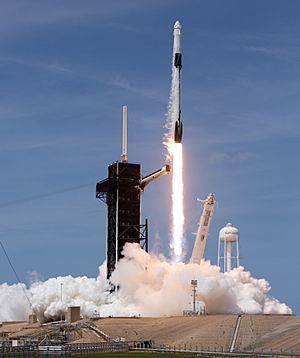Falcon 9 facts for kids
 |
|

|
|
| Function | Orbital launch vehicle |
|---|---|
| Manufacturer | SpaceX |
| Country of origin | United States |
| Cost per launch | US$67 million (2022) |
| Size | |
| Height |
|
| Diameter | 3.7 m (12 ft) |
| Mass |
|
| Stages | 2 |
| Capacity | |
| Payload to Low Earth orbit (LEO) |
|
| Payload to Geosynchronous transfer orbit (GTO) |
|
| Payload to Mars transfer orbit | FT: 4,020 kg (8,860 lb) |
| Associated rockets | |
| Derivatives | Falcon Heavy |
| Launch history | |
| Status |
|
| Launch sites |
|
| Total launches |
|
| Successes |
|
| Failures | 1 (v1.1: CRS-7 in-flight) |
| Partial failures | 1 (v1.0: CRS-1) |
| Other | 1 (FT: AMOS-6 pre-flight destruction) |
| Landings | 292 / 301 attempts |
| First flight |
|
| Last flight |
|
| First stage | |
| Engines |
|
| Thrust |
|
| Specific impulse |
|
| Burn time |
|
| Fuel | LOX / RP-1 |
| Second stage | |
| Engines |
|
| Thrust |
|
| Specific impulse |
|
| Burn time |
|
| Fuel | LOX / RP-1 |
The Falcon 9 is a powerful rocket built by an American company called SpaceX. It is special because it can be used more than once, like a reusable car. This rocket can carry both supplies and astronauts into Earth orbit. It can also launch very heavy things into space.
The first Falcon 9 rocket launched on June 4, 2010. It made history in 2020 by becoming the first private rocket to send humans into orbit. It is the only U.S. rocket approved to take astronauts to the International Space Station (ISS). In 2022, it became the U.S. rocket with the most launches ever. It also has a great safety record, with only one major flight issue.
Contents
How Does the Falcon 9 Rocket Work?
The Falcon 9 rocket has two main parts, called stages. Think of it like a two-part toy rocket.
The First Stage: The Booster
The first stage is the big bottom part. It has nine powerful SpaceX Merlin engines. This stage pushes the rocket and its cargo very fast and high into the sky. After its job is done, the first stage separates.
What makes Falcon 9 amazing is that this first stage can fly back to Earth and land upright! This means it can be used again for future missions. SpaceX first achieved this incredible landing in December 2015. As of today, Falcon 9 boosters have landed successfully many times. Some boosters have flown into space as many as 19 times!
The Second Stage: Reaching Orbit
The second stage is the top part of the rocket. It has one Merlin engine. After the first stage separates, the second stage fires up. It pushes the payload (the satellites or spacecraft) even faster. This helps the payload reach its exact target orbit in space.
Both stages of the rocket use special fuel. They burn super-cold liquid oxygen (LOX) and a type of rocket fuel called RP-1.
What Can Falcon 9 Carry?
The Falcon 9 is known for carrying heavy payloads. It has set records for the most satellites launched at once.
Carrying Satellites
The Falcon 9 has launched some of the heaviest satellites. For example, it carried the Intelsat 35e satellite, which weighed over 6,700 kilograms (about 14,900 pounds). It also launched Telstar 19V, weighing over 7,000 kilograms (about 15,500 pounds).
On January 24, 2021, a Falcon 9 rocket launched 143 satellites into orbit. This was a world record for the most satellites launched by a single rocket!
Carrying Astronauts and Cargo
The Falcon 9 is approved by NASA to carry astronauts to the International Space Station. It also carries important supplies and experiments to the ISS. This makes it a very important rocket for space exploration.
NASA trusts the Falcon 9 for its most important and complex missions. This is because of its strong safety record and reliability.
Different Versions of Falcon 9
Over the years, SpaceX has made different versions of the Falcon 9 rocket. Each new version was an improvement on the last.
- v1.0: This was the first version, flying from 2010 to 2013.
- v1.1: This version flew from 2013 to 2016.
- v1.2 Full Thrust (FT): This version first launched in 2015.
- Block 5: This is the latest and most advanced version of the Full Thrust rocket. It has been in use since May 2018. The Block 5 is designed to be even more reusable.
Related pages
Images for kids
-
Falcon 9 Flight 20 historic first-stage landing at CCAFS, Landing Zone 1, on December 21, 2015.
-
A Falcon 9 v1.0 being launched with a Dragon spacecraft to deliver cargo to the ISS in 2012.
-
Falcon 9's first stage successfully landing on an ASDS for the first time, following the launch of SpaceX CRS-8 to the ISS.
-
SpaceX's Falcon 9 rocket delivered the ABS-3A and Eutelsat 115 West B satellites to a supersynchronous transfer orbit, launching from Space Launch Complex 40 at Cape Canaveral Air Force Station, Florida in March 2015.
See also
 In Spanish: Falcon 9 para niños
In Spanish: Falcon 9 para niños







